

Courtroom Interpreting - Marianne Mason. Do men and women speak the same language? Do men and women speak the same language?

Can they ever really communicate? These questions are not new, but since the early 1990s there has been a new surge of interest in them. Countless self-help and popular psychology books have been written portraying men and women as alien beings, and conversation between them as a catalogue of misunderstandings. The most successful exponents of this formula, such as Deborah Tannen, author of You Just Don't Understand, and John Gray, author of Men Are From Mars, Women Are From Venus, have topped the bestseller lists on both sides of the Atlantic. Advice on how to bridge the communication gulf between the sexes has grown into a flourishing multimedia industry.
Readers who prefer something a little harder-edged can turn to a genre of popular science books with titles such as Brain Sex, Sex on the Brain, The Essential Difference, and Why Men Don't Iron. The growth of call centres is part of a larger trend in economically advanced societies. Men and Women in Interaction : Reconsidering the Differences: Reconsidering ... - Elizabeth Aries Professor of Psychology Amherst College. THE CASE OF THE MISSING MALE READER: IMPLICATIONS OF GENDERLECT AND THE REA...: Resource Finder.
Despite the increasing relationship between literacy and economic opportunities, the time young adult males spend reading has fallen during the last 20 years, with a corresponding decline in their reading levels.
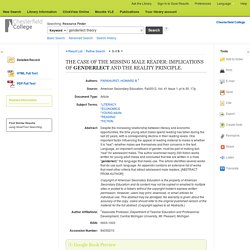
One important factor influencing the appeal of reading material to males is whether it is "real"--whether males see themselves and their concerns in the text. Language, an important constituent of gender, must be part of making text "real" for adolescent males. The author examined nearly 200 fiction works written for young adult males and concluded that few are written in a male "genderlect," the language that males use. The article identifies several works that do use such language. An appendix contains an extensive list of works that meet other criteria that attract adolescent male readers. To the extent that standardized test scores accurately reflect reading ability, 17-year-old American males seem to lag behind the increasing demands for literacy skills in the workplace.
The Women and Language Debate: A Sourcebook - Camille Roman, Suzanne Juhasz, Cristanne Miller. Language and gender. Introduction This guide is written for students who are following GCE Advanced level (AS and A2) syllabuses in English Language.
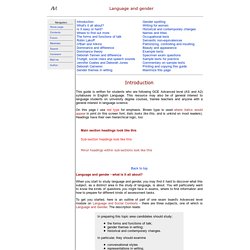
This resource may also be of general interest to language students on university degree courses, trainee teachers and anyone with a general interest in language science. On this page I use red type for emphasis. You Just Don't Understand: Women and Men in Conversation: Amazon.co.uk: Deborah Tannen: 9781853814716: Books. Language and Woman's Place: Text and Commentaries - Robin Tolmach Lakoff, Mary Bucholtz. The 1975 publication of Robin Tolmach Lakoff's Language and Woman's Place, is widely recognized as having inaugurated feminist research on the relationship between language and gender, touching off a remarkable response among language scholars, feminists, and general readers.
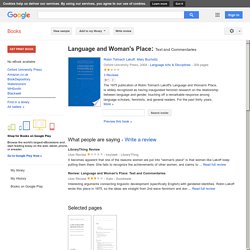
For the past thirty years, scholars of language and gender have been debating and developing Lakoff's initial observations. Arguing that language is fundamental to gender inequality, Lakoff pointed to two areas in which inequalities can be found: Language used about women, such as the asymmetries between seemingly parallel terms like master and mistress, and language used by women, which places women in a double bind between being appropriately feminine and being fully human. Lakoff's central argument that "women's language" expresses powerlessness triggered a controversy that continues to this day.
Amazon.co. Rethinking Language and Gender Research: Theory and Practice - Victoria Bergvall. Rethinking Language and Gender Research is the first book focusing on language and gender to explicitly challenge the dichotomy of female and male use of language.
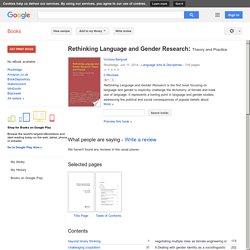
It represents a turning point in language and gender studies, addressing the political and social consequences of popular beliefs about women's language and men's language and proposing new ways of looking at language and gender. The essays take a fresh approach to the study of subjects such as language and sex and the use of language to produce and maintain power and prestige. Topics explored in this text include sex and the brain; the language of a rape hearing; teenage language; radio talk show exchanges; discourse strategies of African American women; political implications for language and gender studies; the relationship between sex and gender and the construction of identity through language.
From Lakoff to Today – The Gender Factor in Spoken Interaction. Robin Lakoff’s Predictions: Robin Lakoff, in 1975, published an influential account of women’s language.

This was the book Language and Woman’s Place. In a related article, Woman’s Language, she published a set of basic assumptions about what marks out the language of women. Among these are claims that women: 1. 2. 3. 4. 5. 6. 7. 8. 9. 10. 11. 12. 13. 14. 15. 16. 17. 18. William O’Barr and Bowman Atkins A 1980 study by William O’Barr and Bowman Atkins looked at courtroom cases and witnesses’ speech. “In an article entitled “‘Women’s Language’ or ‘Powerless Language’?” “O’Barr and Atkins concluded from their study that the quoted speech patterns were “neither characteristic of all women nor limited only to women” (McConnell-Ginet, et al., p. 102). Level Up: English Language - Language and gender. Language and Gender There are two different types of Language and Gender questions you could be asked about: representations of gender and gender in action.

For instance, magazine articles, adverts and books all include representations of gender (usually stereotypes) and not what males and females are really like. It's the perception of a gender difference, not a real gender difference. Transcripts, however, will show you how gender differences affect language (unless they are faked, be careful!)
A distinction you must understand: Language and gender. Women, Gender, and Language in Morocco - Fatima Sadiqi. Gender-and-language. Feminist Philosophy of Language. First published Fri Sep 3, 2004; substantive revision Tue Jun 15, 2010 Much of feminist philosophy of language so far can be described as critical—critical either of language itself or of philosophy of language, and calling for change on the basis of these criticisms.

Those making these criticisms suggest that the changes are needed for the sake of feminist goals — either to better allow for feminist work to be done or, more frequently, to bring an end to certain key ways that women are disadvantaged. In this entry, I examine these criticisms. I also examine work by feminists that seems to suggest some of the criticisms are misplaced: that, for example, philosophy of language is better able to help in feminist projects than critics suppose. My focus in this entry will generally be on the analytic tradition. 1.
False gender-neutrality There has been a great deal of feminist concern over the supposedly gender-neutral use of terms like ‘he’ and ‘man’. 1.2 Invisibility of women 1.8 Metaphor. Language, Gender and Feminism: Theory, Methodology and Practice - Sara Mills,... Language and Woman's Place: Text and Commentaries - Robin Tolmach Lakoff, Mar... The 1975 publication of Robin Tolmach Lakoff's Language and Woman's Place, is widely recognized as having inaugurated feminist research on the relationship between language and gender, touching off a remarkable response among language scholars, feminists, and general readers.
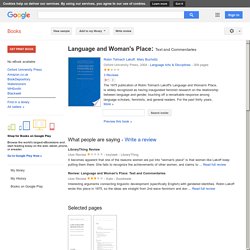
For the past thirty years, scholars of language and gender have been debating and developing Lakoff's initial observations. Arguing that language is fundamental to gender inequality, Lakoff pointed to two areas in which inequalities can be found: Language used about women, such as the asymmetries between seemingly parallel terms like master and mistress, and language used by women, which places women in a double bind between being appropriately feminine and being fully human.
Lakoff's central argument that "women's language" expresses powerlessness triggered a controversy that continues to this day. Giddens 7th Edition. How far are the behaviour and communicative practices of women and men the result of biological differences?
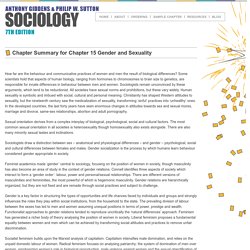
Some scientists hold that aspects of human biology, ranging from hormones to chromosomes to brain size to genetics, are responsible for innate differences in behaviour between men and women. Sociologists remain unconvinced by these arguments, which tend to be reductionist. All societies have sexual norms and prohibitions, but these vary widely. Human sexuality is symbolic and imbued with social, cultural and personal meaning. Christianity has shaped Western attitudes to sexuality, but the nineteenth century saw the medicalization of sexuality, transforming ‘sinful’ practices into ‘unhealthy’ ones. Sexual orientation derives from a complex interplay of biological, psychological, social and cultural factors. Socialist feminism builds upon the Marxist analysis of capitalism. Queer theory breaks with many conventional sociological ideas on identity. Myths of Gender: Biological Theories about Women and Men, Revised Edition - A...
An Introduction to Sociology: Feminist Perspectives - Pamela Abbott, Melissa ...